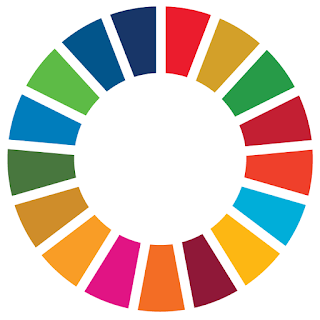6: The system hits hard and who is responsible?
Let’s go back to the Sustainable Development Goals and their
implementation. The SDG’s have been established in september 2016, and endorsed
by all 190 countries in the United Nations of the World. The document is named Transforming
Our World: the 2030 Agenda for Sustainable Development. What follows is a
paper of 41 pages filled with 17 goals and the 169 targets that come with them.
As a continuation of the Millennium Development Goals, the SDG’s are far more
ambitious, and a call to all citizens of the world to make planet Earth a
better place for future generations. But: how do we get all the paperwork into
action? How do we make sure it leaves the UN conference rooms and flows into
our own households? I’m pleading for a truly interdisciplinary approach, with –
in this case- objects as focus.
For example Goal 12 : Ensure Responsible Consumption and
Production. “We envisage a world in which consumption and production patterns
and use of all natural resources are sustainable.” The targets that come with
this goal are in short:
Implement the so-called 10YearsFrameWork, which is about
informing consumers to enable them to make sustainable choices and enhancing
change through policy and new business models. Developed countries must take the
lead in this.
Halve food waste and food losses, reduce waste in general
(reduce, reuse, recycle), encourage companies to get on board, ensure there is
enough information for all citizens about sustainable lifestyle, develop tools
to monitor, restructure taxation and inefficient fossil-fuel subsidies.
Now this is just one goal, among 16 others, and it’s good to
realize this should be implemented in all 190 countries. Taken into account of
course local circumstances. Also, each goal is related to the others, they are
all intertwined. When you think of implementation, it dazzles, and could easily
put you off. So that’s why I want to begin with a thing.
A chair, spoon, coat, blanket, hair comb, plate, bike, bag, doll, glass, cupboard, vase, ball, computer, candle, hammer, bucket, lamp, toothbrush, shirt, box, clock, waste bin, sewing machine, carpet, bracelet, salt mill, cushion, toy, radio, radiator, jar, pencil, watering can, peg, scarf, fridge, coffee maker, bowl, floor tile, key, towel, paperclip, wire, umbrella....
Just by looking around us we see how many objects we own. And each object is designed, produced, transported, sold and bought.
All part of a world-wide system in which materials, methods, trade, habits and economy are involved. And, as Rau and Oberhuber write in their book Material Matters (2016) all is part of a locked system. On our planet every part of every thing is in that sense equally important. Whether small, complicated, cheap or expensive. It is a linear system, in which responsibility is blurred and in fact handed over to the next level. What happens is what in social psychology is called ' diffusion of responsibility'. Market, production, consumption and eventually waste; each is a link in the chain. The consumer is the last link in that chain. Without any knowledge of decisions that have been take in the preceding process, consumers have the responsibility how to use the thing they just bought. By the scale of the system, Rau and Oberhuber mention the 'bystander effect'. No one does anything because no one does. It's changing; we do recycle, we reduce waste. But with hardly any effective result on the global scale.
This relates to what Papanek (1995) Crocker (2012) and Kuchler (2015) in the previous chapter mean. If consumers don't understand the impact of material and the social role of consumption, how can they be responsible citizens?
So what does the ambition of SDG 12 imply from this perspective? A quote: " We commit to making fundamental changes in the way that our societies produce and consume goods and services. Governments, international organizations, the business sector and other non-state actors and individuals must contribute to changing unsustainable consumption and production patterns, including through the mobilization, from all sources, of financial and technical assistance to strengthen developing countries' scientific, technological and innovative capacities to move towards more sustainable patterns of consumption and production. We encourage the implementation of the 10-Years-Framework of Programmes on Sustainable Consumption and Production Patterns. All countries take action, with developed countries taking the lead, taking into account the development and capabilities of developing countries."
Indeed ambitious. Implementation "means a revitalized global partnership", "indicators are being developed to assist" and "it is we the peoples that embark on this journey".
So let's return to a thing, an object.
Just by looking around us we see how many objects we own. And each object is designed, produced, transported, sold and bought.
All part of a world-wide system in which materials, methods, trade, habits and economy are involved. And, as Rau and Oberhuber write in their book Material Matters (2016) all is part of a locked system. On our planet every part of every thing is in that sense equally important. Whether small, complicated, cheap or expensive. It is a linear system, in which responsibility is blurred and in fact handed over to the next level. What happens is what in social psychology is called ' diffusion of responsibility'. Market, production, consumption and eventually waste; each is a link in the chain. The consumer is the last link in that chain. Without any knowledge of decisions that have been take in the preceding process, consumers have the responsibility how to use the thing they just bought. By the scale of the system, Rau and Oberhuber mention the 'bystander effect'. No one does anything because no one does. It's changing; we do recycle, we reduce waste. But with hardly any effective result on the global scale.
This relates to what Papanek (1995) Crocker (2012) and Kuchler (2015) in the previous chapter mean. If consumers don't understand the impact of material and the social role of consumption, how can they be responsible citizens?
So what does the ambition of SDG 12 imply from this perspective? A quote: " We commit to making fundamental changes in the way that our societies produce and consume goods and services. Governments, international organizations, the business sector and other non-state actors and individuals must contribute to changing unsustainable consumption and production patterns, including through the mobilization, from all sources, of financial and technical assistance to strengthen developing countries' scientific, technological and innovative capacities to move towards more sustainable patterns of consumption and production. We encourage the implementation of the 10-Years-Framework of Programmes on Sustainable Consumption and Production Patterns. All countries take action, with developed countries taking the lead, taking into account the development and capabilities of developing countries."
Indeed ambitious. Implementation "means a revitalized global partnership", "indicators are being developed to assist" and "it is we the peoples that embark on this journey".
So let's return to a thing, an object.



Reacties
Een reactie posten